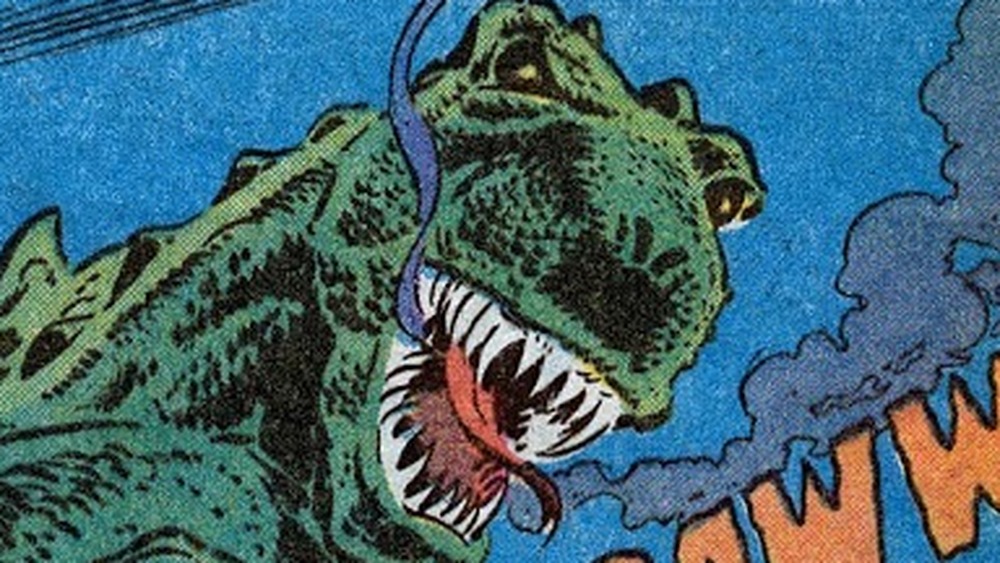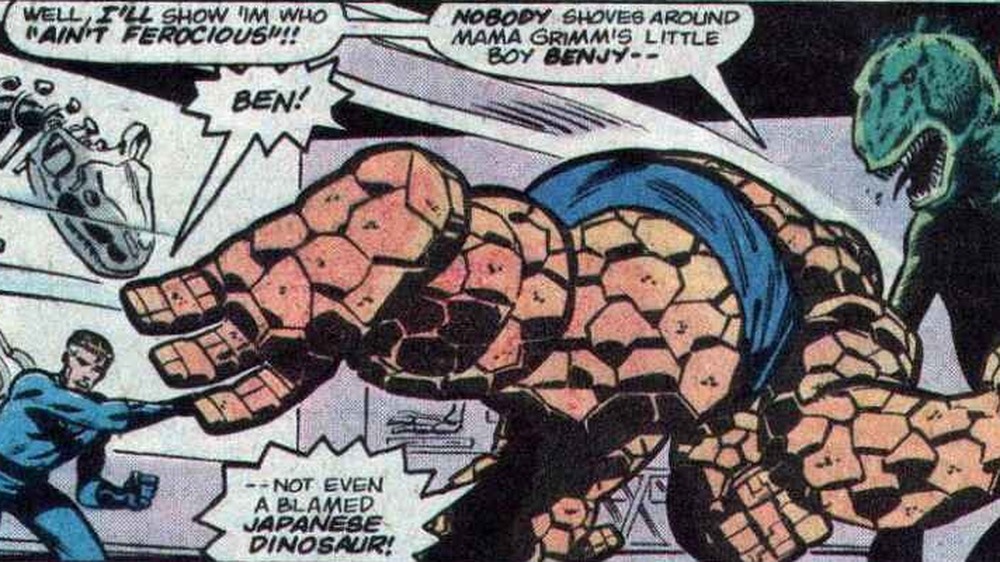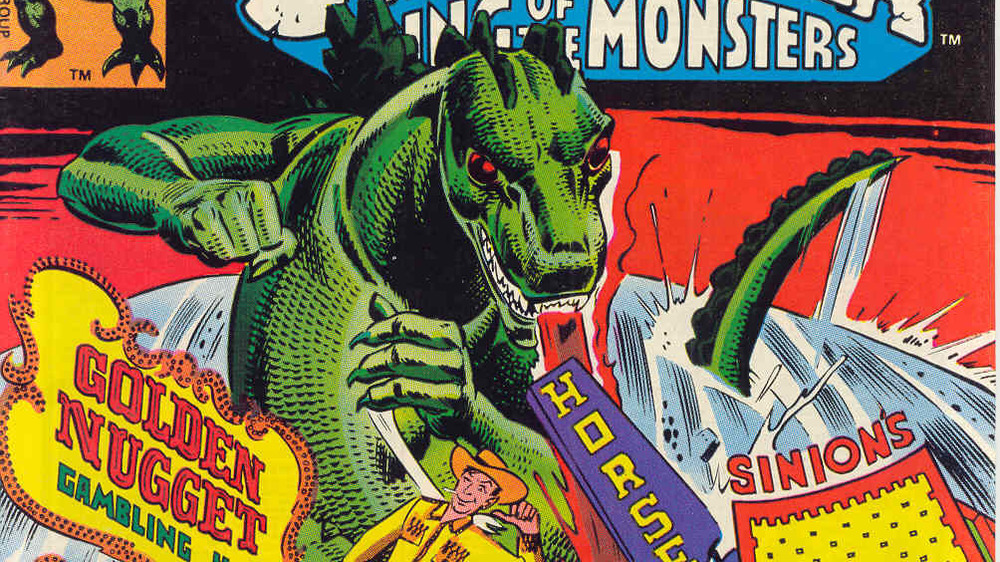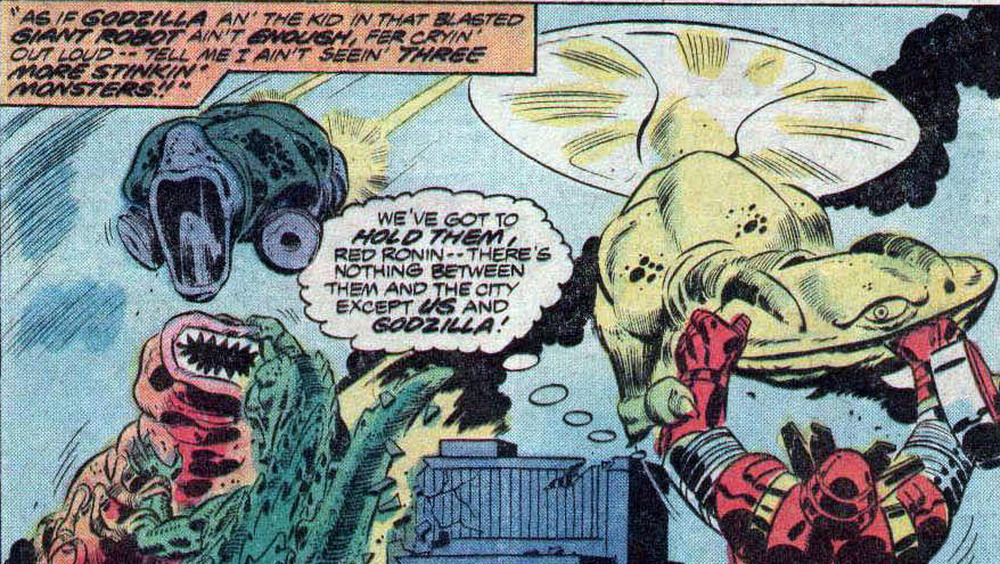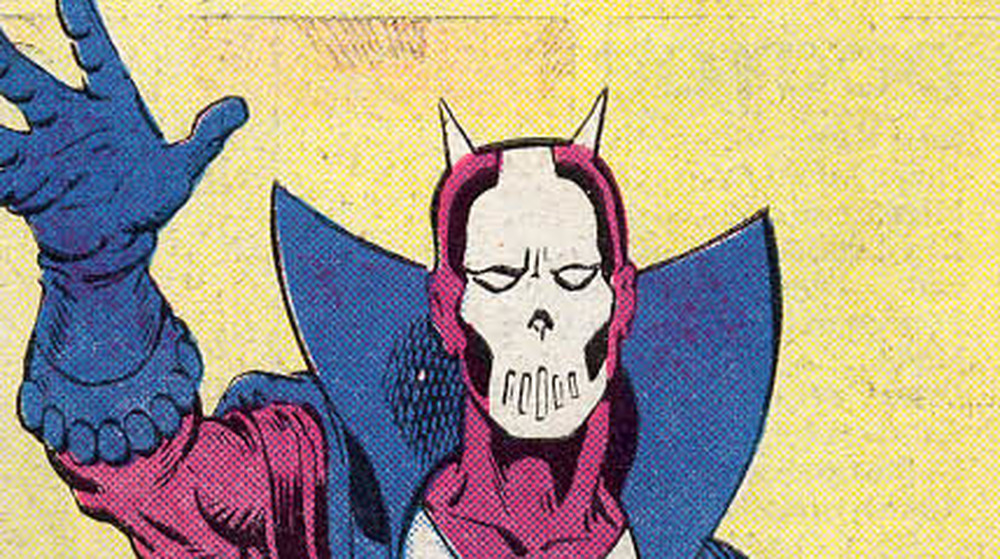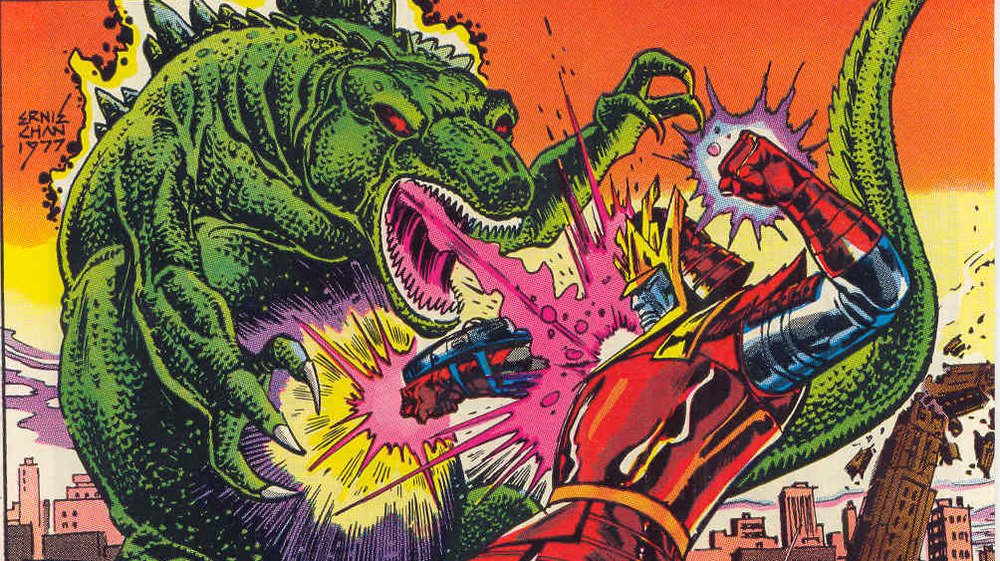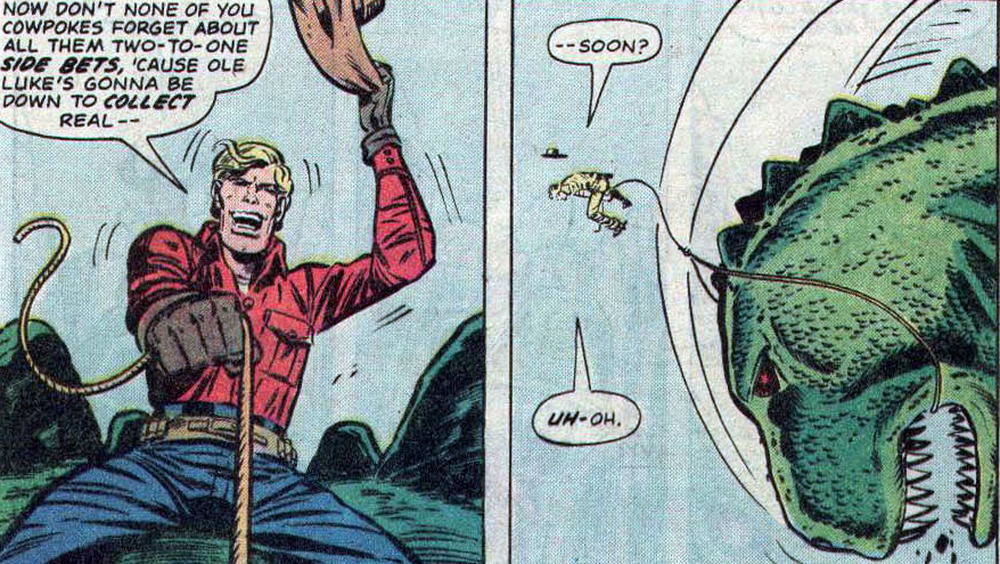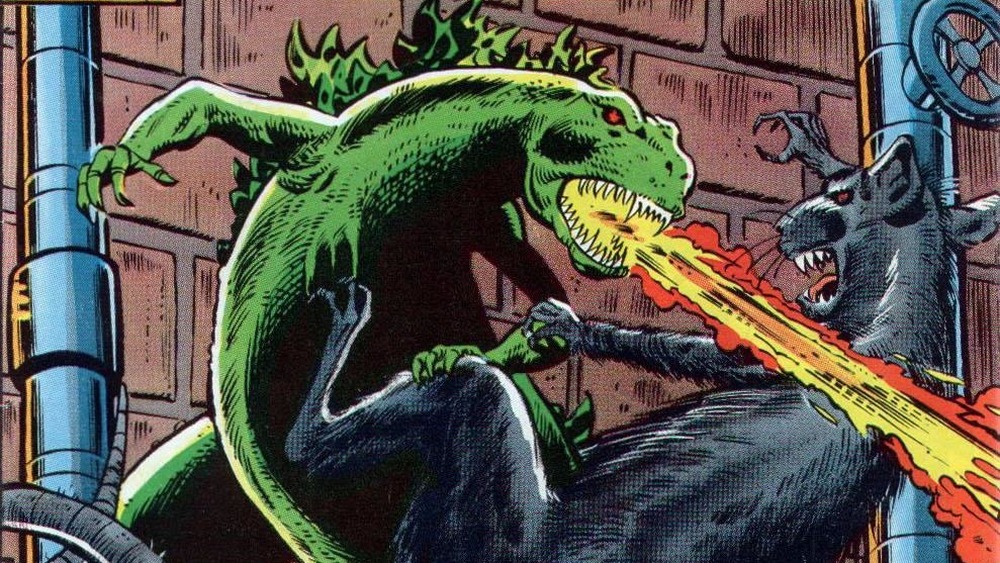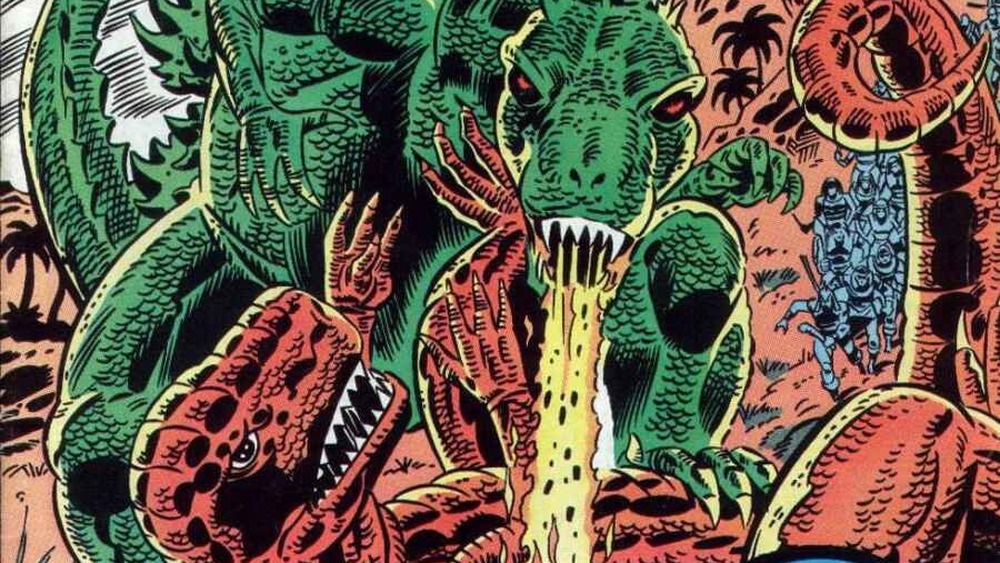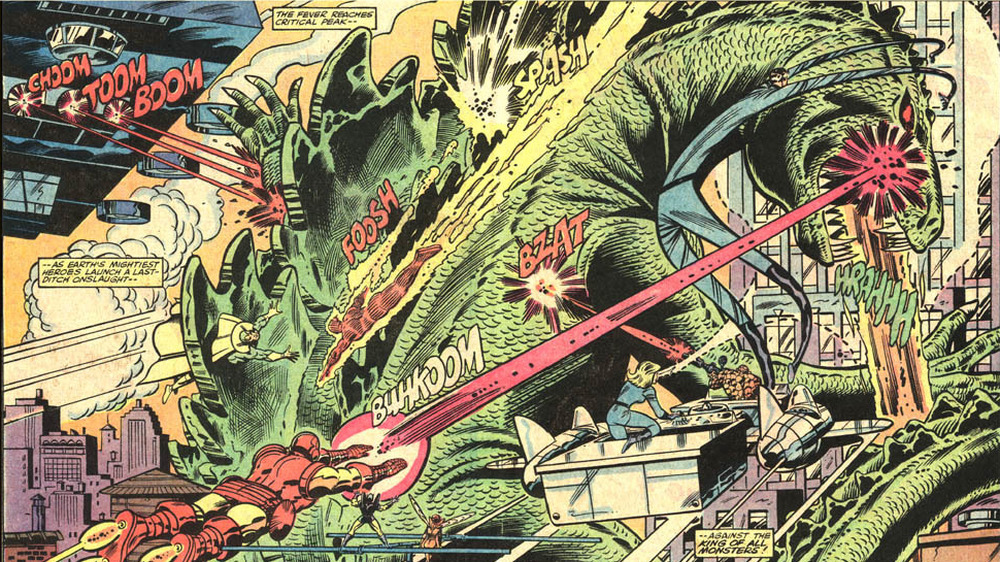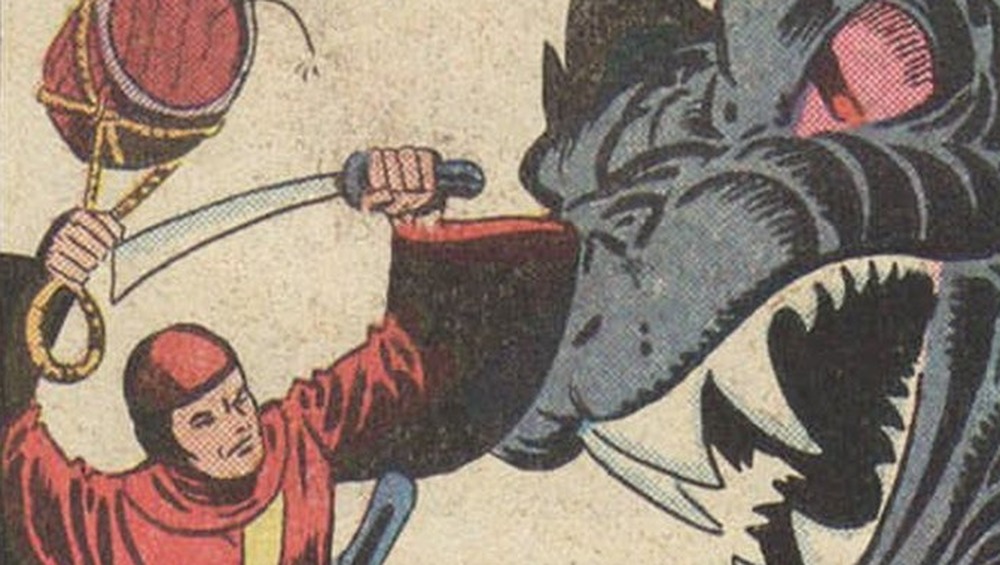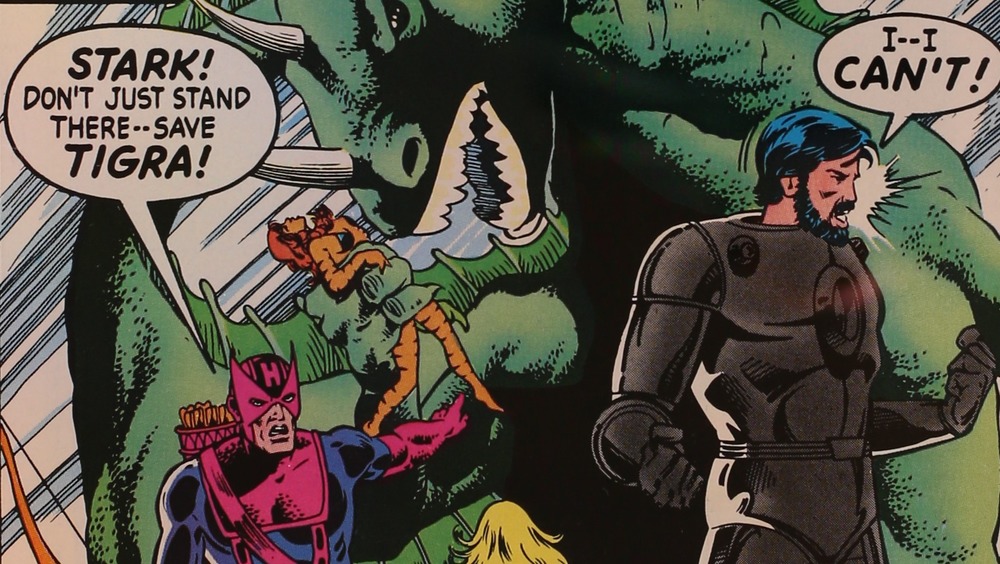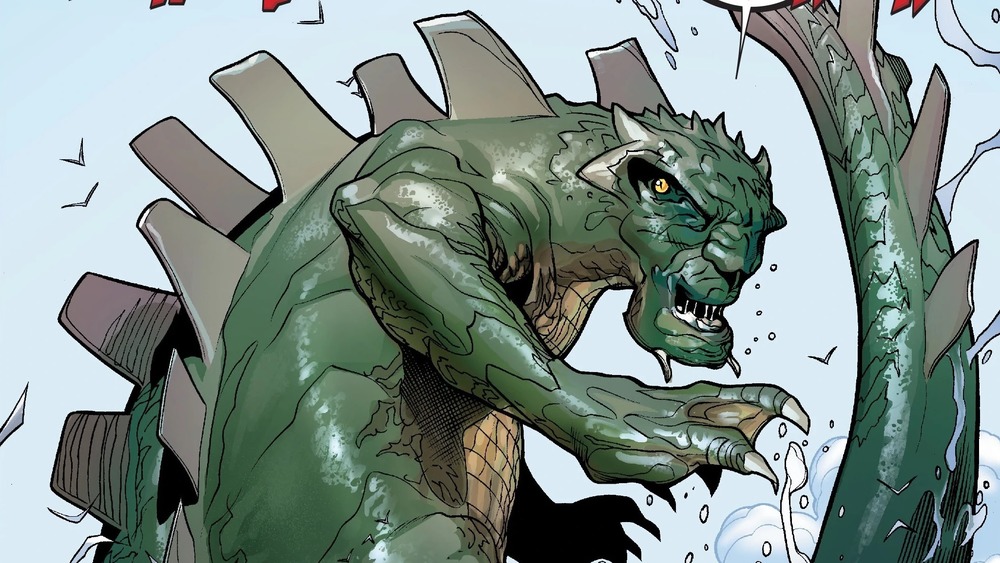The History Of Godzilla In Marvel Comics Explained
With the new series of Monsterverse movies, Legendary Pictures and Warner Brothers are out to beat Marvel at their own game. The franchise offers its own take on Marvel's revolutionary, not to mention profitable, "cinematic universe" model with a series of interconnected giant monster movies linked by the presence of a secretive government agency — Monarch, which does for monsters what S.H.I.E.L.D. did for superheroes. It all comes to a head in Godzilla vs. Kong, the Avengers of the Monsterverse, where we finally get to see two icons of the genre on the same screen for the first time since 1962.
We can go on looking at parallels between the two franchises as long as you'd like. But there was a time in the '70s when Godzilla and the Marvel Universe came much closer than that. From 1977-78, Marvel Comics struck a deal with Godzilla's wranglers at Toho Studios for a comics series that saw the King of the Monsters fighting with the Avengers, the Fantastic Four, the agents of S.H.I.E.L.D., and a host of others, plus some new but still very Marvel-ish creations. It was a truly strange meeting of the worlds, and we've broken it all down for you below.
The Godzilla comics dropped him right in the middle of the Marvel Universe
Marvel publishing their own Godzilla comics isn't that odd — many other publishers have tried their hand at the franchise, from Dark Horse to IDW to the current comics produced in-house at Legendary. But Marvel's writers couldn't resist tying their work into the Marvel Universe even with characters Marvel didn't actually own — they teamed up Conan the Barbarian with every superhero imaginable and developed a complex backstory for Hasbro's ROM toy line that still plays a major role in the Marvel Universe even though ROM himself can no longer appear.
That's what happened with Godzilla. It came with a full supporting cast borrowed from Marvel's war comic, Sgt. Fury and His Howling Commandos, and its successor, Nick Fury: Agent of S.H.I.E.L.D. Agents Dum Dum Dugan and Gabe Jones get the assignment to clean up after Godzilla along with another Marvel mainstay, Agent Jimmy Woo, who you more likely recognize from WandaVision. New characters included Dr. Yuriko Takiguchi, who'd studied Godzilla's past rampages through Japan; his grandson Rob; and his assistant Tamra Hashioka.
There was also inventor Hugh Howards, a blatantly obvious stand-in for the real-life Howard Hughes, whose inventions include the gigantic airborne troop transport nicknamed the Spruce Goose. And if you think the name's unsubtle, just wait until you hear the tortured metaphors he uses just to make sure readers get the gag.
The writer wasn't a fan
Combining the worlds of Godzilla and Marvel Comics would have been a dream assignment for many writers, but Doug Moench wasn't one of them. The scripter had established himself as a star at Marvel with his work on Master of Kung Fu and Werewolf by Night, so it makes sense that Marvel would tap him for the series along with Hulk artist Herb Trimpe. But he explained to SyFy Wire why he didn't volunteer: "As a kid, I saw what was probably a re-release of the Raymond Burr-eviscerated version of the first movie. I remember thinking, 'Gorgo was cooler.'"
A special screening of one of the newer installments didn't change his opinion, but at least one person in the audience enjoyed it: "It was a piece of crap, but Stan [Lee] was sitting next to me hooting and hollering and clapping. He went crazy during the fight scenes, shouting, 'Go get 'em, Godzy!'" Fellow Marvel writer-editor Roger Stern added, "Stan was trying to show enthusiasm in front of the Toho execs...At the end, after we've watched this terrible movie with these awful special effects, Stan shouted, 'Take that, Star Wars!'"
Moench still rose to the challenge, but it's easy to tell he didn't come to Godzilla from any longtime attachment — for one thing, the grayish creature of the Toho movies turned bright green in the comics. His trackers are even called the Green Team!
Godzilla fought all-new, all-weird monsters
The Godzilla Universe is just as rich as the Marvel Universe — you could even argue its creators over at Toho did the whole cinematic universe thing long before Marvel thought of it. But none of those characters appear in the comics — except for one creature called Lepirax that looks a lot like Mothra. Why's that? The answer comes down to cold, hard cash. According to Doug Moench, "We would have had to pay Toho the same amount for each one."
Fortunately, Moench was up to the challenge of coming up with new monsters. Some weren't too creative — since Moench couldn't use Baragon from Frankenstein Conquers the World and Destroy All Monsters, he apparently added an extra letter to create Batragon, who's literally a bat-dragon.
Others were downright surreal. In one story, nuclear tests wake up a frozen sasquatch and turn him into the Godzilla-sized Yetrigar. In another, Godzilla becomes the pawn of an alien empire that tests his mettle with a big-lipped, bug-eyed monstrosity covered in spine-shooting tentacles. Then the aliens send Godzilla back to Earth to defend it from even stranger monsters. One has a propeller in its posterior and a clam for a head with one red eye and loads of sharp little teeth. Another is a rhino-turtle-thing with big, round eyes on retractable stalks sticking out of its neck that fires jets out of its feet. The last one's a massive worm that shoots debris out of its mouth.
Marvel gave Godzilla his very own arch-nemesis
Marvel's Godzilla was just as much a Marvel comic as it was a Godzilla comic. That meant it needed some good old-school Marvel super-villains. But what kind of super-villain could possibly pose a threat to a 10-story-tall radioactive dinosaur?
Enter Dr. Demonicus. He has a classic super-villain origin as a mad scientist who worked too closely with radiation for his own good, but with a twist — he doesn't actually get any superpowers, just a brain tumor. He also uses the radiation from what he calls the "Lifestone” to turn ordinary animals into Godzilla-sized monsters so he can conquer the world.
When Godzilla stumbles across Dr. Demonicus's Bond-villain hideout in the heart of a volcano, the mad scientist sends his pet monsters to dispatch both Godzilla and the S.H.I.E.L.D. agents he's inadvertently led to the secret lair. Demonicus also has a nasty habit of addressing Gabe Jones as "Black man." Destroying the world we can take, but that's just over the line!
Even though Marvel's deal to create Godzilla comics only lasted two years, it didn't say anything about the rights to characters created in those comics, and Dr. Demonicus has been surprisingly durable. He's fought Iron Man, the Avengers, and another team of Japanese-inspired heroes in Shogun Warriors under his creator's pen. And even if he doesn't get to be the star attraction too often, you can count on Demonicus to show up in the background of any scene where Marvel's villains get together.
Godzilla teamed up with a new robotic hero
Inspired by Godzilla's popularity with the kids in his neighborhood, Doug Moench gave younger readers a character to identify with in little Robbie Takiguchi. He comes from a long tradition of child stars in Japanese movies starring Godzilla and other monsters. Like Gamera's Toshio, Robbie bonds with the giant monster and tries to keep the military men from hurting him. And like Toshio, you have to wonder how he's so sure the creature's basically good, considering the body count he keeps racking up.
In Godzilla #6, Robbie steps into a role from another Japanese genre when S.H.I.E.L.D. comes up with their latest anti-Godzilla weapon, a giant robot called the Red Ronin. Ronnie commandeers it, causing the robot to bond with his brainwaves so no one else can drive it, and uses it to protect Godzilla and fight other monsters. Meanwhile, the rest of S.H.I.E.L.D. yells at him to, if we can paraphrase a popular Neon Genesis Evangelion meme, get out of the f**king robot.
Much like the movies' Jet Jaguar, this development was inspired by the popular "mecha" genre of anime, right down to giving the giant machine a prepubescent pilot. In the letters pages, Doug Moench cites Raiden the Brave as his main inspiration, and he'd later go on to write the real thing in Marvel's adaptation of the Japanese Shogun Warriors action figures.
Marvel gave us the world's first Godzilla western
As the series went on, Moench and Trimpe got creative, or even downright weird, with new adventures for Godzilla to go on. After saving Earth from the alien Mega-Monsters, Godzilla takes a breather on a ranch in Utah in issue #15. His eating habits get the attention of some of the local cowhands, who — thinking they've discovered where all their missing cattle have gone — decide they're gonna rope them a Godzilla.
Encouraging this bizarre turn of events is rancher Bill Ford, the actual cattle thief, who hopes to keep his neighbors off his trail so he can buy up their land. It's every bit as surreal as it sounds to see Godzilla plonked right in the middle of an old-school Western plotline, and if there's any doubt that's what Moench is doing, he names his cast after the legends of the genre. Along with Bill Ford, we've also got characters named John Hawks, Lefty Walsh, and Hal Wellman. Some of the strange sights you'll see in these issues include a cowboy riding Godzilla's tail like a bucking bronco while tying a bundle of dynamite to it, and later roping him around the jaw.
Godzilla had some strange adventures of all sizes
After The Great Godzilla Roundup, things don't necessarily get weirder, but they at least keep up a steady pace of strangeness in issue #17. Dum Dum Dugan realizes the best solution to a monster so big that it can't help destroying everything in its path is to make it smaller. So he contacts Dr. Henry Pym, a.k.a. Ant-Man, to whip up some shrinking gas for the King of the Monsters. It works long enough to transport Godzilla to New York, but then he escapes into the sewers in #18, where we get a brutal and truly surreal monster fight at a minuscule scale between the Big Little G and a sewer rat. Later, Robbie recovers Godzilla just as the shrinking gas starts wearing off. Robbie disguises his scaly pal in a trenchcoat and fedora, Teenage Mutant Ninja Turtles-style, much to the surprise of some would-be muggers.
Godzilla's grown to twenty feet by the time S.H.I.E.L.D. catches up with him and tries to lure him into the Museum of Natural History in #20. But at the same time, the Fantastic Four hear the news of a giant lizard terrorizing the city and ruin S.H.I.E.L.D.'s plans by agitating the skittish monster. At one point, we even get to see what a Godzilla-Jaws crossover might look like when the Fantastic Four's Thing accidentally wrestles Godzilla into a tank, helpfully identified by a nearby poster: "This week only ... LIVE SHARKS!"
Godzilla battles another classic Marvel monster at the dawn of time
The Fantastic Four may cause some problems with S.H.I.E.L.D.'s Godzilla-napping operation, but they also provide a new solution before the big G can get back to full, city-stomping size. He's a dinosaur awoken in the wrong time — why not send him back to where and when he belongs? The Fantastic Four still have a time machine they requisitioned from their nemesis Dr. Doom, so in #21, they plop Godzilla in it and send him back to the Mesozoic Era.
This gives Moench and Trimpe an ideal chance to cross their book over with another dinosaur-themed comic that debuted the previous year. Jack Kirby, creator of the Avengers, the X-Men, and just about every other Marvel hero, returned to the company he helped build in 1976 with a hatful of new ideas, including Devil Dinosaur. Fresh off creating strange future worlds for DC Comics with OMAC and Kamandi, Kirby turned his imagination in the opposite direction to create a prehistoric world for the proto-human Moon Boy and his faithful red tyrannosaurus. Devil survives his fight with Godzilla long enough to travel to the present and befriend a girl genius in the recent Moon Girl and Devil Dinosaur series, which we'll see as an animated series soon. As for Godzilla, he ends up back in the present a lot sooner when the nuclear radiation that first woke him up overloads the time machine and slingshots him back to the present.
A battle royale with the Avengers wrapped the series
With Godzilla back in Manhattan and at full size, it'll take all of Earth's Mightiest Heroes to save the city in issues 23–24. They assemble to fight him, leading to some spectacular scenes like Thor struggling to keep Godzilla from toppling over a building. In the end, though, none of the superheroes are super enough to defeat the giant lizard. In fact, no one physically beats him at all. Instead, it comes down to little Robbie Takiguchi to talk him down. Thanks to the bond they've built over the past two years, Robbie convinces Godzilla to walk away into the ocean, and the narration assures us he's not coming back.
So what killed Marvel's Godzilla? Were the sales too low, were the monster's owners in Japan unhappy, was it the airplanes, or did beauty kill the beast? None of the above — the SyFy Wire article reveals Godzilla could have continued turning a steady profit if Toho hadn't asked for a bigger slice of it. They renewed and renegotiated their contract with Marvel one year at a time, and each time they tried to double the cost of the license. That almost ended the series after the first year, but Marvel managed to talk them down. Then their luck ran out the second time around, and Godzilla just couldn't earn his keep at that price.
Marvel repurposed an unused Godzilla story
The end of Godzilla left Marvel with a whole comic they had no place to use. CBR reports that Marvel commissioned legendary Teen Titans writer Marv Wolfman and Spider-Man and Doctor Strange co-creator Steve Ditko to put together an extra issue of Godzilla they could publish if Moench and Trimpe ever fell behind. But Godzilla's cancellation left the story without a book to run in, and few comic book fans would like the thought of an entire book of Ditko artwork ending up in the garbage.
So Marvel got a little creative with it. They published Wolfman and Ditko's story in Marvel Spotlight #5 as the first appearance of a new hero called Dragon Lord with some tweaks to Godzilla's design to sneak him past the lawyers (ironically, this involved restoring the movie's gray color scheme).
As you might expect for a character whose only purpose was to sneak an unused story onto the racks, Dragon Lord never became a hot commodity at Marvel. More unexpectedly, he finally did show up again in Avengers: The Initiative over 25 years later and even got a dramatic death scene.
Godzilla made more legally dubious appearances in Marvel comics
Marvel's deal with Toho may have ended, but that didn't stop them from finding ways to hide Godzilla and the concepts introduced in his comics under the lawyers' radar. Red Ronin kept bopping around the Marvel Universe, with or without Robbie. The Loners #5 introduced a new, more humanoid version, and the Green Goblin even commandeered the original for his Thunderbolts team when he managed to wrangle himself a high-ranking government position. Even Yetrigar made a comeback in West Coast Avengers Vol. 2 #32, where Mockingbird wakes him up to keep her teammates busy while she deals with some private business. In The Incredible Hercules #115, Herc and his pal Amadeus Cho hijack the Green Team's Behemoth airship and a S.H.I.E.L.D. agent gives a carefully worded version of its backstory: "S.H.I.E.L.D. built her to hunt that giant lizard that crawled out of the Sea of Japan back in the day."
Seven years after the Godzilla book ended, a familiar monster showed up in the pages of Iron Man #193 by Denny O'Neill and Luke McDonnell. So did Dr. Demonicus, who explains he's taken control of his "once-greatest enemy," which conveniently happens to involve mutating him so he no longer looks like Toho's trademarked image.
Dr. Takiguchi reappeared with a Godzilla of his own
Matt Fraction teamed up with artists Terry and Rachel Dodson to bring back the Green Team's Godzilla expert Dr. Takiguchi in Uncanny X-Men #506. After the Scarlet Witch depowered most of the mutants in House of M, the Beast is trying to put together an "X-Club" of top scientists to find a way to save the species. That means recruiting Dr. Takiguchi, who S.H.I.E.L.D. has set up on a disputed island between Russia and Japan. While there, he's applied his research to creating some monsters of his own, and the X-Club has to fight off some crab creatures to get to Takiguchi's lab. There, they make the unpleasant discovery that the scientist has gotten paranoid in his own age. Assuming the intruders are Russian invaders, Takiguchi went for the nuclear option: a very Godzilla-looking critter he calls "Leviathan."
We also learn the sad fate of Little Robbie, but at least his grandfather assures us that he "died a hero" even if he won't say how. The X-Club defeats the Leviathan, of course. But somewhere in the Marvel Universe, the real Godzilla is still lurking around, bound to raise his ugly head with a purposeful grimace and a terrible sound someday. Earth's mightiest heroes couldn't stop him — how could lawyers?
